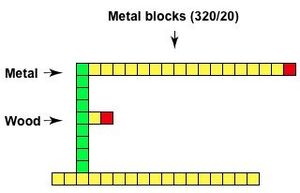Introduzione[ | ]
Una delle parti più importanti del gameplay è la costruzione, come sopravvissuto è importante conoscere le basi della fisica e del mondo di gioco perchè non è bello veder crollare quella passerella che avevamo costruito per scappare in caso le mura non avessero retto agli zombi, quindi eccomi qui a spiegarti come rendere ciò che costruisci stabile e solido.
Basi[ | ]
Per cominciare ti spiegherò effettivamente come capire se i blocchi che stai piazzando sono messi bene o potrebbero cadere da un momento all'altro. Il gioco ci facilità questa cosa mettendo a disposizione uno strumento grafico che appare quando stai piazzando un blocco, ovvero una sagoma colorata. Questa sagoma colorata può essere di tre colori differenti:
- Giallo - Più è chiaro più non c'è da preoccuparsi, man mano che continui a piazzare blocchi diventa più scuro che vuol dire che è ancora stabile ma sarebbe meglio rinforzare la struttura prima di continuare.
- Rosso - Se la sagoma è di questo colore vuol dire che se piazzerai questo blocco la struttura collasserà fino alla sua sezione più stabile, rinforzando la struttura si può prevenire.
- Rosa/Fucsia - il blocco non ha nessun supporto quindi collasserà, succede se provi a piazzare un blocco in aria.
Matematica dei blocchi[ | ]
I blocchi hanno un peso ed un massimo peso sostenuto per farti capire meglio prendiamo le informazioni dei blocchi di legno ovvero Peso: 5 e Massimo peso sostenuto: 40. Questo vuol dire che ogni faccia di un cubo di legno può sostenere fino a 40 di peso, quindi essendo che il peso di un cubo di legno è 5 potremo piazzare altri 8 blocchi prima di dover rinforzare la struttura. Se proviamo a piazzare blocchi di metallo vedremo che dopo 2 ci sarà la sagoma rossa, questo perchè il blocco di metallo ha un peso di 20.
Costruzione Verticale[ | ]
Quando si costruisce in verticale non c'è nessun problema di peso e di materiale perchè si può salire quanto si vuole anche se non è una buona idea costruire la propria base su un blocco perchè gli zombi ci metteranno un secondo a buttarti giù. Il problema di pone quando andremo ad espanderci perchè dovremo pensare al materiale che vogliamo usare (se usiamo il legno per il pillar potremo espanderci molto poco mentre se useremo il metallo potremo espanderci molto di più.

Some examples with all wood[ | ]
- Green = pillar. Connects all the way down to Bedrock with 0 air blocks in between.
- Yellow = supported block. Structural Integrity values apply.
- Red = Forget it. It's too much mass and the block will not stick. If it does stick you destabilise your construction and get "random blocks falling off"... somewhere.
- Note that some "wood" blocks are weaker than the regular frame. Shingles are the typical example. Pay attention to tool-tips.
Strike the earth![ | ]
- No, really, don't... unless you know precisely what you're doing.
- See what happens? The entire pillar is now a "supported block" instead of supporting other blocks.
- Tread carefully with your mining/digging, otherwise Fun may ensue.
The Magic 8 Block[ | ]
- A ceiling / bridge / whatever will break if you step on block #9 from a support and if the ceiling is 1 block thick.
- Why? Because.
The Game Messing With You[ | ]
- The new poured concrete is a great example.
- The rebar frames are metal (320/20).
- If you "upgrade" them to the wooden cast or fresh concrete level, they will have wood stats (24/5).
- Guess what happens if you upgrade the pillar to 24 SI while the rest of the construction still has 20 mass per block.
- It's silly, but you need a lot of temporary supports if you want to use poured concrete anywhere but on flat ground.
Overview[ | ]
WARNING: A lot of this has changed since Alpha 13 and may not be relevant anymore.
Structural Integrity describes how many blocks of one material can be used to build an unsupported structure.
One example for such a structure is a horizontal beam. It is important that the player uses the same block for the base as for the beam itself.
There are some limitations to this.
- It is not possible to build a beam longer than 15 blocks. The 16th block simply drops and doesn't stick to the beam.
- A beam longer than eight blocks will partially collapse when stepped on the 9th block. This is also true for platforms; any block further away than 8 blocks from the base will fall if stepped on. Every block between you and the base counts; if you build 3 blocks straight, 2 to the side and than 3 straight again, counts as 8 blocks. Adding any further block and stepping on it will cause it to fall.
Metallic Blocks[ | ]
Contrary to popular belief, Metal Trussing and other metallic blocks do not act differently than, for example, stone blocks. Metallic blocks mostly have a Max Load of 320 and a Mass of 20; what would make a structural integrity of 16, but due to the limitation at 15 it seems like structural integrity for metallic blocks is 15 and they break partially. If the player builds a plateau 4x4 instead of a beam he reaches the 16 blocks maximum and may walk on this plateau. Add a 17th block anywhere and the whole structure collapses.
Calculation[ | ]
In order to calculate the structural integrity, divide Max Load by Mass of the block and round down the quotient.
Structural Integrity = RoundDown ( Max Load ÷ Mass )
questo è il numero di blocchi che puoi aggiungere. per avere il supporto da una parte, una piattaforma deve essere connessa ad essa. I.e. a wooden frame platform of 4x4 blocks has to connect to three sides of the base, to get support for up to 18 blocks. A platform of 3x4 wooden frames only needs to connect to two sides of the base, because that would be enough to get support for 12 blocks. Not counting in these platforms is the base itself as it does not need any support (obviously), making the effective platform 19 / 13 blocks big. Those platforms do not have to be a rectangle.
The maximum number of unsupported blocks includes those you build on other unsupported blocks. If you build a beam of 4 wooden frames on the side of a base wooden frame, you can add two additional wooden frames on top of any other of the four unsupported blocks (it does not matter if both are on top of each other or on different blocks). Adding a 7th wooden frame anywhere on the beam makes the complete beam fall to the ground.
Examples[ | ]
- Metal Trussing: 320 ÷ 20 = 16 Structural Integrity for Metal Trussing is 16.
- Reinforced Concrete Blocks: 110 ÷ 15 = 7.33 RoundDown(7.33) = 7 Structural Integrity for Reinforced Concrete Blocks is 7.
- Cobblestone Blocks: 90 ÷ 15 = 6 Structural Integrity for Cobblestone Blocks is 6.
- Concrete Blocks: 90 ÷ 15 = 6 Structural Integrity for Concrete Blocks is 6.
- Brick Blocks: 65 ÷ 13 = 5 Structural Integrity for Brick Blocks is 5.
- Sand: 0 ÷ 8 = 0 Structural Integrity for Sand is 0.
Bridges[ | ]
- Metal Trussing pillar will support ,as of Alpha 15b8, a 3x14 bridge of wood frames upgraded to first metal band form connected to three facings of the pillar. The facing pointing away will not add to the structures strength going out. (the center row will extend one block)
Using different materials[ | ]
If you use different materials, the number of unsupported blocks is calculated using the following formula
Minimum of ((MaxLoad of BaseBlock : Mass of UnsupportedBlock) AND (number of unsupported blocks you could add if you had used the same material for the base and the beam))
I.e. concrete (MaxLoad 90, Mass 15) and wooden frame (MaxLoad 36, Mass 6)
- a) Using concrete as the base and wooden frames as the beam; in this case you can add 6 wooden frames at the side of the concrete block.
- b) Using wooden frame as the base and concrete as the beam; in this case you can add 2 concrete blocks at the side of the wooden frame.
Video Tutorial (Alpha 15)[ | ]
The video below explains the physics of mass and max load for various building materials in detail as of alpha 15.
